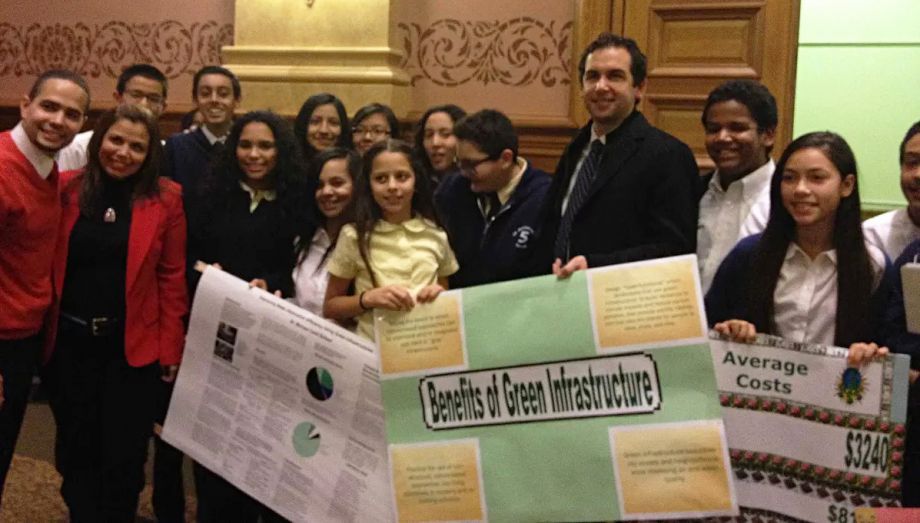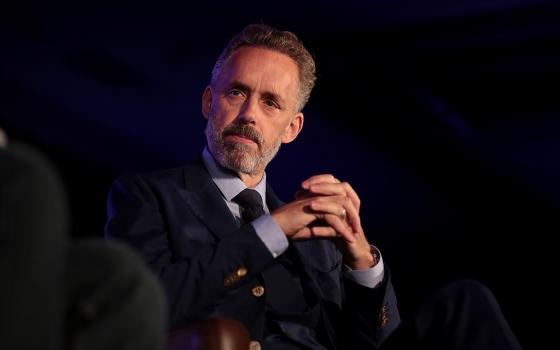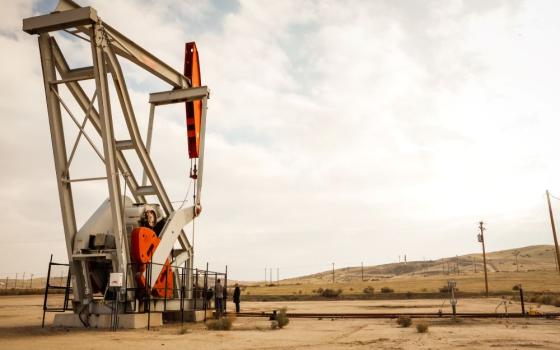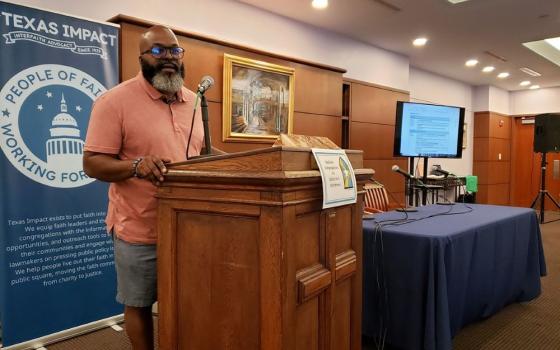
Students from PS5 in Jersey City meet with Mayor Steve Fulop to present their plan to stop flooding in front of their school (NextCity.org/Courtesy of PS5 Eco-Cougars)
Editor's note: This story originally appeared at NextCity.org and is republished here as part of Covering Climate Now, a global journalism collaboration strengthening coverage of the climate story.

In downtown Jersey City, Dr. Michael Conti Public School No.5 (PS5) uses project-based learning to encourage kids to think about solutions to real-life problems affecting their community. In this diverse school, where about 50% of the student body are economically disadvantaged, a classroom of kids noticed an urban design flaw in need of a fix and got the New Jersey Water Bank to fund it.
The source of the problem was right on top of their school. Every time there was a storm, rainwater from the roof would flow into one storm drain until it was full, and then the excess water would flood the street in front of PS5. It was so bad that parents and buses had to navigate around the water. Teachers moved their parked cars away from the school to avoid flooding.
"When a thunderstorm was forecasted, you knew there were certain areas not to park," recalls Albert Padilla, former science teacher at PS5, which serves pre-K to eighth grade, and now science supervisor for the School District of Jersey City.
"One-fifth of our students are driven to school, so in the morning and the afternoon we have a huge backlog of cars. So when it would rain, it would make the situation a lot worse," explains Principal John Rivero. "I remember cars getting on the sidewalk to avoid the water."
A permanent solution became necessary in 2011 after Hurricane Irene and then Superstorm Sandy the following year. Frustrated, the kids, not faculty nor their parents, decided to do something about it.
The students were already learning about water conservation in Padilla's class when they asked him what could be done. "In that flooding, we found out that it was also dragging all the pollutants into the water, like motor oil." says Padilla. It was later discovered that nitrogen, phosphorus and suspended solids were also in the surface runoff. "I thought it would be great to not only mitigate the stormwater but also find a way to filter some of that going into the sewer system."
Padilla researched different solutions that the students could pursue, and that is when he stumbled upon green infrastructure — an umbrella term for using plants or landscaping to capture stormwater. Padilla learned about it at the same time as the students. They were impressed by how green infrastructure could simultaneously mitigate flooding and look appealing.
Advertisement
"Once we saw what green infrastructure was and how it could be implemented, the students ran wild with it," remembers Padilla. "They were looking at green roofs, rain garden systems for the front of the school and permeable pavement. That's when we knew we had to expand outside of the classroom, because it was getting above our pay grade."
By the fall of 2013, Padilla and his students were ready to start the project but first had to figure out how much runoff was coming from the roof of the school. They found the average rainfall for Jersey City online and went up to their multiple-level roof to take measurements.
"When we got up there, we quickly realized that we couldn't measure the square-footage of our roof with yard sticks," says Padilla. "So I got the kids to use Google Maps, did a scale and proportion of the building to get the area of the roof, and calculated the stormwater coming off that."
Not being a water resource engineer, Padilla approached Rosana Da Silva at Rutgers University, who was then an associate for the Cooperative Extension Water Resources Program, which works with communities to address water issues.
Da Silva and the rest of her team members took the calculations Padilla and his students did in class to verify their accuracy. The middle schoolers were a little off, but close enough for the Water Resources Program to join the project. With Da Silva on board, Padilla sought her guidance in creating a water conservation and stormwater management lesson, which took the students' project-based learning to a whole new level.
"At the time, I was able to leverage funding from two grants to support my time and effort to work with Mr. Padilla and his students," writes Da Silva in an email about preparing the lesson. "This included assisting the students in how to conduct a school ground inspection to identify different opportunities for green infrastructure, selecting the right types of green infrastructure practices for the space, and communicating the multiple benefits of green infrastructure."
They selected three solutions: two raised pre-cast concrete stormwater planters adjacent to the building to collect and absorb runoff from the roof into an underground discharge pipe, two curbside stormwater planters to receive roadway runoff, and pervious concrete on the sidewalk to allow stormwater to infiltrate below to a perforated pipe underdrain.
After a few years of work, the students succeeded in raising awareness about the project. Parents and other faculty members started to get excited about it, then the community and the school district were too. Padilla even created a website to chronicle the work the students were doing. "Mr. Padilla and I were in communication often to discuss the students' progress, review students' work, and discuss ways in which the students could build upon their effort, including applying to Eco-Schools, Samsung Solve for Tomorrow, and other initiatives," says Da Silva.
Then they reached out to Jersey City Councilman Rich Boggiano who visited the school for the students to present the project to him. Boggiano loved the idea and encouraged the students to present it at a city council meeting. Though this project seemed to be going far, the process was much longer than the students realized.
"After we presented to City Hall, it kind of went quiet for a while. We did a fundraiser and got about $6,000 from the community and parents," recalls Padilla. He and Rivero laugh now, but they thought that the solution would cost about that amount. As more public entities got involved it became clear that it would cost much more.
While the students waited to see if their proposal would be approved, the Water Resources Program staff were discussing the benefits of the PS5 project with the Jersey City Municipal Utilities Authority (JCMUA). Both organizations believed that they could leverage funding to implement the project so that it could serve as an example for other schools in the city. Without the JCMUA elevating the project to one of Mayor Steven Fulop's green infrastructure priorities, PS5's project would have never happened.
The New Jersey Water Bank saw the potential in the PS5 project, and loaned the JCMUA $6.6 million, much of it forgivable. As Da Silva describes it, once the city saw that the JCMUA had secured the funding, it was easy for the project to get political support.
Even before PS5 changed architecturally, the buzz from the project changed the school academically. As more students saw the potential of what their education could do, PS5 expanded its STEM curriculum. Students who were not planning to pursue a career in the sciences changed their minds. Enrollment in after-school science, technology, engineering and math programs went up, and PS5 became known as a hub in the city for innovative kids. By the time the project was completed in 2017, many of the students who started the idea had become STEM majors in college. Some came back for the unveiling to see the finished product of their vision, and today a couple are engineers.
With the flooding gone and the school beautified, every day students are reminded of the power of education to change the world around them. The most important lesson PS5 students learn cannot be found in textbooks nor on a blackboard, but right in front of the school itself.
"Throughout the process, the kids were learning critical thinking, self-management skills, and the importance of asking questions. It was a huge learning process not only for the kids, but for us as educators," says Rivero, who has effusive praise for the teacher who inspired his students to think outside of the box. "Mr. Padilla was my rock star science teacher for 15 years, and now he's the rock star science supervisor for the school district. He's continuing the work he did at PS5, and taking it out to the district as a whole. He could have taught them from a book about water runoff, but they would've forgotten about it."
[This article is part of NextCity.org's Financing Our Green Future, a mini-series examining the behind-the-scenes roles green banks play in making a more sustainable world. This series is generously supported by the Solutions Journalism Network.]






